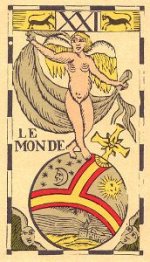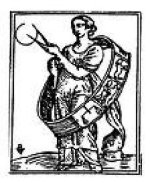jmd
Well - here we are!
This card certainly has had some transformations through history, and yet remained, on the whole, reasonably consistent in its iconography (the Visconti-Sforza illustrations which Kaz will hopefully also post being the other main type of depiction).
The main change has been, from my perspective, the possible ambiguity or 'maleness' of most early depictions modified to clearly feminine depictions. There are numerous depictions of Christ which are so similar to this one that, to my mind at least, the card undoubtedly depicted Christ in its early renditions. I say this even more because, of all late mediaeval depictions one would expect, a depiction of the crucifixion would have been 'expected' - unless one is dealing with some Christian view either deemed heretical, or closely aligned to such. In such cases, Christ's depiction would have been included in its fulness of spiritual being - as Logos.
The four living creatures from Ezekiel are also the four Evangelists, arranged in one of their traditional order, and the order aligned with the four fixed signs of the zodiac.
But enough of my brief introduction - attached is the 1701 Dodal rendition.
This card certainly has had some transformations through history, and yet remained, on the whole, reasonably consistent in its iconography (the Visconti-Sforza illustrations which Kaz will hopefully also post being the other main type of depiction).
The main change has been, from my perspective, the possible ambiguity or 'maleness' of most early depictions modified to clearly feminine depictions. There are numerous depictions of Christ which are so similar to this one that, to my mind at least, the card undoubtedly depicted Christ in its early renditions. I say this even more because, of all late mediaeval depictions one would expect, a depiction of the crucifixion would have been 'expected' - unless one is dealing with some Christian view either deemed heretical, or closely aligned to such. In such cases, Christ's depiction would have been included in its fulness of spiritual being - as Logos.
The four living creatures from Ezekiel are also the four Evangelists, arranged in one of their traditional order, and the order aligned with the four fixed signs of the zodiac.
But enough of my brief introduction - attached is the 1701 Dodal rendition.








